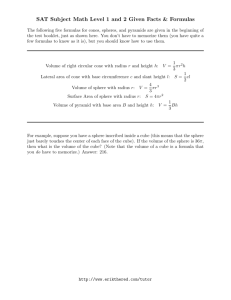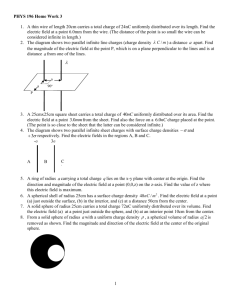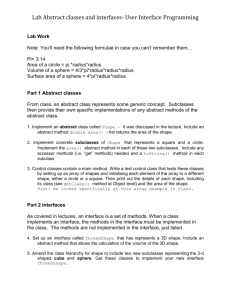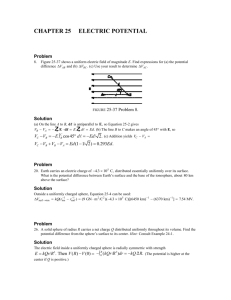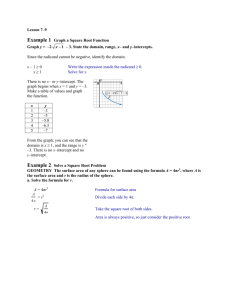A conducting circular disk has a uniform positive surface charge
advertisement
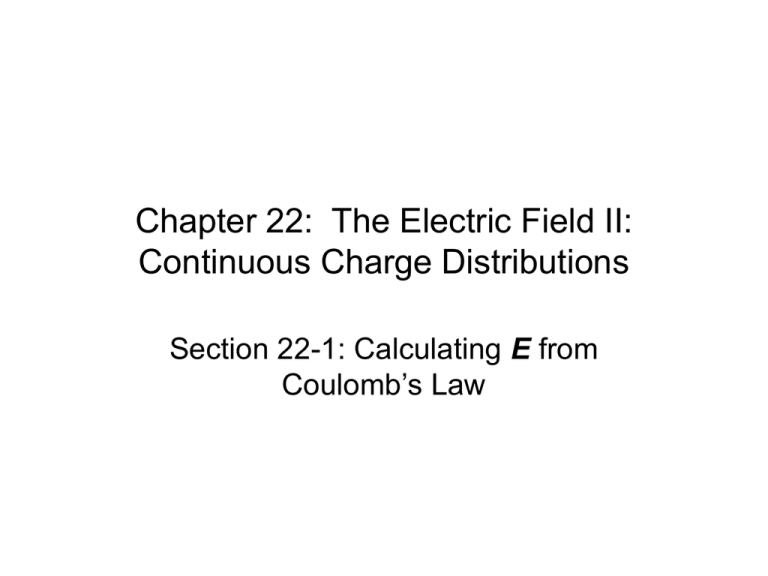
Chapter 22: The Electric Field II: Continuous Charge Distributions Section 22-1: Calculating E from Coulomb’s Law A conducting circular disk has a uniform positive surface charge density. Which of the following diagrams best represents the electric field lines from the disk? (The disk is drawn as a cross– section.) A. 1 B. 2 1 2 C. 3 D. 4 E. None of the diagrams. 3 4 A conducting circular disk has a uniform positive surface charge density. Which of the following diagrams best represents the electric field lines from the disk? (The disk is drawn as a cross– section.) A. 1 B. 2 1 2 C. 3 D. 4 E. None of the diagrams. 3 4 An infinite plane lies in the yzplane and it has a uniform surface charge density. The electric field at a distance x from the plane A. decreases linearly with x. B. decreases as 1/x2. C. is constant and does not depend on x. D. increases linearly with x. E. is undetermined. An infinite plane lies in the yzplane and it has a uniform surface charge density. The electric field at a distance x from the plane A. decreases linearly with x. B. decreases as 1/x2. C. is constant and does not depend on x. D. increases linearly with x. E. is undetermined. A uniform circular ring has charge Q and radius r. A uniformly charged disk also has charge Q and radius r. Calculate the electric field due to the ring at a distance of r along the axis of the ring divided by the electric field due to the disk at a distance of r along the axis of the disk. A. 1.0 B. 0.60 C. 1.7 D. 0.50 E. 0.85 A uniform circular ring has charge Q and radius r. A uniformly charged disk also has charge Q and radius r. Calculate the electric field due to the ring at a distance of r along the axis of the ring divided by the electric field due to the disk at a distance of r along the axis of the disk. A. 1.0 B. 0.60 C. 1.7 D. 0.50 E. 0.85 Chapter 22: The Electric Field II: Continuous Charge Distributions Section 22-2: Gauss’s Law A cubical surface with no charge enclosed and with sides 2.0 m long is oriented with right and left faces perpendicular to a uniform electric field E of (1.6 105 N/C) in the +x direction. The net electric flux fE through this surface is approximately A. zero B. 6.4 105 N · m2/C C. 13 105 N · m2/C D. 25 105 N · m2/C E. 38 105 N · m2/C A cubical surface with no charge enclosed and with sides 2.0 m long is oriented with right and left faces perpendicular to a uniform electric field E of (1.6 105 N/C) in the +x direction. The net electric flux fE through this surface is approximately A. zero B. 6.4 105 N · m2/C C. 13 105 N · m2/C D. 25 105 N · m2/C E. 38 105 N · m2/C A surface is so constructed that, at all points on the surface, the E vector points inward. Therefore, it can be said that A. the surface encloses a net positive charge. B. the surface encloses a net negative charge. C. the surface encloses no net charge. A surface is so constructed that, at all points on the surface, the E vector points inward. Therefore, it can be said that A. the surface encloses a net positive charge. B. the surface encloses a net negative charge. C. the surface encloses no net charge. A surface is so constructed that, at all points on the surface, the E vector points outward. Therefore, it can be said that A. the surface encloses a net positive charge. B. the surface encloses a net negative charge. C. the surface encloses no net charge. A surface is so constructed that, at all points on the surface, the E vector points outward. Therefore, it can be said that A. the surface encloses a net positive charge. B. the surface encloses a net negative charge. C. the surface encloses no net charge. The figure shows a surface enclosing the charges q and –q. The net flux through the surface surrounding the two charges is A. q/0 B. 2q/0 C. –q/0 D. zero E. –2q/0 The figure shows a surface enclosing the charges q and –q. The net flux through the surface surrounding the two charges is A. q/0 B. 2q/0 C. –q/0 D. zero E. –2q/0 The figure shows a surface enclosing the charges 2q and –q. The net flux through the surface surrounding the two A. q 0 charges is 2q B. ε0 C. q 0 D. zero 3q E. 0 The figure shows a surface enclosing the charges 2q and –q. The net flux through the surface surrounding the two A. q 0 charges is 2q B. ε0 C. q 0 D. zero 3q E. 0 The figure shows a surface, S, with two charges q and –2q. The net flux through the surface is A. q 0 2q B. ε0 s +q C. 2q q 0 D. zero 3q E. 0 The figure shows a surface, S, with two charges q and –2q. The net flux through the surface is A. q 0 2q B. ε0 s +q C. 2q q 0 D. zero 3q E. 0 A hollow spherical shell of radius 5.36 cm has a charge of 1.91 mC placed at its center. Calculate the electric flux through a portion of the shell with an area of 1.20 10–2 m2. A. 6.48 105 N.m2/C B. 2.16 105 N.m2/C C. 7.20 104 N.m2/C D. 2.16 101 N.m2/C E. None of the above. A hollow spherical shell of radius 5.36 cm has a charge of 1.91 mC placed at its center. Calculate the electric flux through a portion of the shell with an area of 1.20 10–2 m2. A. 6.48 105 N.m2/C B. 2.16 105 N.m2/C C. 7.20 104 N.m2/C D. 2.16 101 N.m2/C E. None of the above. A horizontal surface of area 0.321 m2 has an electric flux of 123 N.m2/C passing through it at an angle of 25° to the horizontal. If the flux is due to a uniform electric field, calculate the magnitude of the electric field. A. 907 N/C B. 423 N/C C. 1.10 10–3 N/C D. 2.36 10–3 N/C E. 383 N/C A horizontal surface of area 0.321 m2 has an electric flux of 123 N.m2/C passing through it at an angle of 25° to the horizontal. If the flux is due to a uniform electric field, calculate the magnitude of the electric field. A. 907 N/C B. 423 N/C C. 1.10 10–3 N/C D. 2.36 10–3 N/C E. 383 N/C Chapter 22: The Electric Field II: Continuous Charge Distributions Section 22-3: Using Symmetry to Calculate E with Guass’s Law, and Concept Check 22-1 The electric field E in Gauss’s Law is A. only that part of the electric field due to the charges inside the surface. B. only that part of the electric field due to the charges outside the surface. C. the total electric field due to all the charges both inside and outside the surface. The electric field E in Gauss’s Law is A. only that part of the electric field due to the charges inside the surface. B. only that part of the electric field due to the charges outside the surface. C. the total electric field due to all the charges both inside and outside the surface. A rod of infinite length has a charge per unit length of l (= q/l). Gauss's Law makes it easy to determine that the electric field strength at a perpendicular distance r from the rod is, in terms of k = (40)–1, k A. r2 k B. r 4k C. r 2k D. r E. zero A rod of infinite length has a charge per unit length of l (= q/l). Gauss's Law makes it easy to determine that the electric field strength at a perpendicular distance r from the rod is, in terms of k = (40)–1, k A. r2 k B. r 4k C. r 2k D. r E. zero A solid sphere of radius a is concentric with a hollow sphere of radius b, where b > a. If the solid sphere has a uniform charge distribution totaling +Q and the hollow sphere a charge of –Q, the electric field magnitude at radius r, where r < a, is which of the following, in terms of k = (40)–1? A. B. C. D. E. kQ r2 kQr a3 kQ a2 kQ b2 zero A solid sphere of radius a is concentric with a hollow sphere of radius b, where b > a. If the solid sphere has a uniform charge distribution totaling +Q and the hollow sphere a charge of –Q, the electric field magnitude at radius r, where r < a, is which of the following, in terms of k = (40)–1? A. B. C. D. E. kQ r2 kQr a3 kQ a2 kQ b2 zero A solid sphere of radius a is concentric with a hollow sphere of radius b, where b > a. If the solid sphere has a uniform charge distribution totaling +Q and the hollow sphere a charge of –Q, the electric field magnitude at radius r, where a < r < b, is which of the following, in terms of k = (40)–1? A. B. C. D. E. kQ r2 2kQ r2 kQ a2 kQ b2 kQ (b a ) 2 A solid sphere of radius a is concentric with a hollow sphere of radius b, where b > a. If the solid sphere has a uniform charge distribution totaling +Q and the hollow sphere a charge of –Q, the electric field magnitude at radius r, where a < r < b, is which of the following, in terms of k = (40)–1? A. B. C. D. E. kQ r2 2kQ r2 kQ a2 kQ b2 kQ (b a ) 2 A solid sphere of radius a is concentric with a hollow sphere of radius b, where b > a. If the solid sphere has a uniform charge distribution totaling +Q and the hollow sphere a charge of –Q, the electric field magnitude at radius r, where r > b, is which of the following, in terms of k = (40)–1? A. B. C. D. E. kQ r2 2kQ r2 kQ a2 kQ b2 zero A solid sphere of radius a is concentric with a hollow sphere of radius b, where b > a. If the solid sphere has a uniform charge distribution totaling +Q and the hollow sphere a charge of –Q, the electric field magnitude at radius r, where r > b, is which of the following, in terms of k = (40)–1? A. B. C. D. E. kQ r2 2kQ r2 kQ a2 kQ b2 zero A sphere of radius 8.0 cm carries a uniform volume charge density r = 500 nC/m3. What is the electric field magnitude at r = 8.1 cm? A. 0.12 kN/C B. 1.5 kN/C C. 0.74 kN/C D. 2.3 kN/C E. 12 kN/C A sphere of radius 8.0 cm carries a uniform volume charge density r = 500 nC/m3. What is the electric field magnitude at r = 8.1 cm? A. 0.12 kN/C B. 1.5 kN/C C. 0.74 kN/C D. 2.3 kN/C E. 12 kN/C A spherical shell of radius 9.0 cm carries a uniform surface charge density s = 9.0 nC/m2. The electric field magnitude at r = 4.0 cm is approximately A. 0.13 kN/C B. 1.0 kN/C C. 0.32 kN/C D. 0.75 kN/C E. zero A spherical shell of radius 9.0 cm carries a uniform surface charge density s = 9.0 nC/m2. The electric field magnitude at r = 4.0 cm is approximately A. 0.13 kN/C B. 1.0 kN/C C. 0.32 kN/C D. 0.75 kN/C E. zero A spherical shell of radius 9.0 cm carries a uniform surface charge density s = 9.0 nC/m2. The electric field magnitude at r = 9.1 cm is approximately A. zero B. 1.0 kN/C C. 0.65 kN/C D. 0.32 kN/C E. 0.13 kN/C A spherical shell of radius 9.0 cm carries a uniform surface charge density s = 9.0 nC/m2. The electric field magnitude at r = 9.1 cm is approximately A. zero B. 1.0 kN/C C. 0.65 kN/C D. 0.32 kN/C E. 0.13 kN/C An infinite plane of surface charge density s = +8.00 nC/m2 lies in the yz plane at the origin, and a second infinite plane of surface charge density s = –8.00 nC/m2 lies in a plane parallel to the yz plane at x = 4.00 m. The electric field magnitude at x = 3.50 m is approximately A. 226 N/C B. 339 N/C C. 904 N/C D. 452 N/C E. zero An infinite plane of surface charge density s = +8.00 nC/m2 lies in the yz plane at the origin, and a second infinite plane of surface charge density s = –8.00 nC/m2 lies in a plane parallel to the yz plane at x = 4.00 m. The electric field magnitude at x = 3.50 m is approximately A. 226 N/C B. 339 N/C C. 904 N/C D. 452 N/C E. zero An infinite plane of surface charge density s = +8.00 nC/m2 lies in the yz plane at the origin, and a second infinite plane of surface charge density s = –8.00 nC/m2 lies in a plane parallel to the yz plane at x =4.00 m. The electric field magnitude at x = 5.00 m is approximately A. 226 N/C B. 339 N/C C. 904 N/C D. 452 N/C E. zero An infinite plane of surface charge density s = +8.00 nC/m2 lies in the yz plane at the origin, and a second infinite plane of surface charge density s = –8.00 nC/m2 lies in a plane parallel to the yz plane at x =4.00 m. The electric field magnitude at x = 5.00 m is approximately A. 226 N/C B. 339 N/C C. 904 N/C D. 452 N/C E. zero An infinite slab of thickness 2d lies in the xz–plane. The slab has a uniform volume charge density r. The electric field magnitude at y = b where 0 < b < d is A. 4πkρb z B. 2πkρb d d 4πkρ C. b 2πkρ D. b 4πkρ x E. b2 y An infinite slab of thickness 2d lies in the xz–plane. The slab has a uniform volume charge density r. The electric field magnitude at y = b where 0 < b < d is A. 4πkρb z B. 2πkρb d d 4πkρ C. b 2πkρ D. b 4πkρ x E. b2 y An infinite slab of thickness 2d lies in the xz–plane. The slab has a uniform volume charge density r. The electric field magnitude at y = b where b > d is 4kr A. b 4kr B. d2 C. 4krd D. 2krd 4kr E. d z d d y x An infinite slab of thickness 2d lies in the xz–plane. The slab has a uniform volume charge density r. The electric field magnitude at y = b where b > d is 4kr A. b 4kr B. d2 C. 4krd D. 2krd 4kr E. d z d d y x An infinite slab of thickness 2d lies in the xz–plane. The slab has a uniform volume charge density r. Which diagram best represents the electric field along the y–axis? z d d y x E. None of the diagrams. An infinite slab of thickness 2d lies in the xz–plane. The slab has a uniform volume charge density r. Which diagram best represents the electric field along the y–axis? z d d y x E. None of the diagrams. Chapter 22: The Electric Field II: Continuous Charge Distributions Section 22-4: Discontinuity of En A thin conducting plane with surface charge density s is exposed to an external electric Eext. The difference in the electric field between one surface of the plane to the other surface is A. s/0 B. s/0 Eext C. s/0 Eext D. 2s/0 Eext E. s/20 Eext Eext s A thin conducting plane with surface charge density s is exposed to an external electric Eext. The difference in the electric field between one surface of the plane to the other surface is A. s/0 B. s/0 Eext C. s/0 Eext D. 2s/0 Eext E. s/20 Eext Eext s Chapter 22: The Electric Field II: Continuous Charge Distributions Section 22-5: Charge and Field at Conductor Surfaces Electrical conductors contain A. only free electrons. B. only bound electrons. C. both free and bound electrons. D. neither bound nor free electrons. E. only protons and neutrons. Electrical conductors contain A. only free electrons. B. only bound electrons. C. both free and bound electrons. D. neither bound nor free electrons. E. only protons and neutrons. The electric field at the surface of a conductor A. is parallel to the surface. B. depends only on the total charge on the conductor. C. depends only on the area of the conductor. D. depends only on the curvature of the surface. E. depends on the area and curvature of the conductor and on its total charge. The electric field at the surface of a conductor A. is parallel to the surface. B. depends only on the total charge on the conductor. C. depends only on the area of the conductor. D. depends only on the curvature of the surface. E. depends on the area and curvature of the conductor and on its total charge. A solid conducting sphere of radius ra is placed concentrically inside a conducting spherical shell of inner radius rb1 and outer radius rb2. The inner sphere carries a charge Q while the outer sphere does not carry any net charge. The electric field for ra r rb1 is A. B. C. D. E. kQ 2 rˆ r kQ rˆ 2 r 2kQ rˆ r 2kQ rˆ r zero ra Q rb1 rb2 A solid conducting sphere of radius ra is placed concentrically inside a conducting spherical shell of inner radius rb1 and outer radius rb2. The inner sphere carries a charge Q while the outer sphere does not carry any net charge. The electric field for ra r rb1 is A. B. C. D. E. kQ 2 rˆ r kQ rˆ 2 r 2kQ rˆ r 2kQ rˆ r zero ra Q rb1 rb2 A solid conducting sphere of radius ra is placed concentrically inside a conducting spherical shell of inner radius rb1 and outer radius rb2. The inner sphere carries a charge Q while the outer sphere does not carry any net charge. The electric field for rb1 r rb2 is kQ A. 2 rˆ r kQ B. rˆ 2 r ra 2kQ C. rˆ Q rb1 r 2kQ D. rˆ r rb2 E. zero A solid conducting sphere of radius ra is placed concentrically inside a conducting spherical shell of inner radius rb1 and outer radius rb2. The inner sphere carries a charge Q while the outer sphere does not carry any net charge. The electric field for rb1 r rb2 is kQ A. 2 rˆ r kQ B. rˆ 2 r ra 2kQ C. rˆ Q rb1 r 2kQ D. rˆ r rb2 E. zero A solid conducting sphere of radius ra is placed concentrically inside a conducting spherical shell of inner radius rb1 and outer radius rb2. The inner sphere carries a charge Q while the outer sphere does not carry any net charge. The electric field for r rb1 is kQ A. 2 rˆ r kQ B. rˆ 2 r ra 2kQ Q rb1 C. rˆ r 2kQ rb2 D. rˆ r E. zero A solid conducting sphere of radius ra is placed concentrically inside a conducting spherical shell of inner radius rb1 and outer radius rb2. The inner sphere carries a charge Q while the outer sphere does not carry any net charge. The electric field for r rb1 is kQ A. 2 rˆ r kQ B. rˆ 2 r ra 2kQ Q rb1 C. rˆ r 2kQ rb2 D. rˆ r E. zero The charge on an originally uncharged insulated conductor is separated by induction from a positively charged rod brought near the conductor. For which of the various Gaussian surfaces represented by the dashed lines does E ds 0 ? A. S1 B. S2 C. S3 D. S4 E. S5 The charge on an originally uncharged insulated conductor is separated by induction from a positively charged rod brought near the conductor. For which of the various Gaussian surfaces represented by the dashed lines does E ds 0 ? A. S1 B. S2 C. S3 D. S4 E. S5


